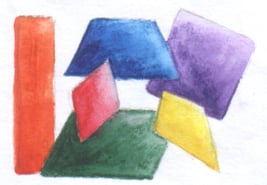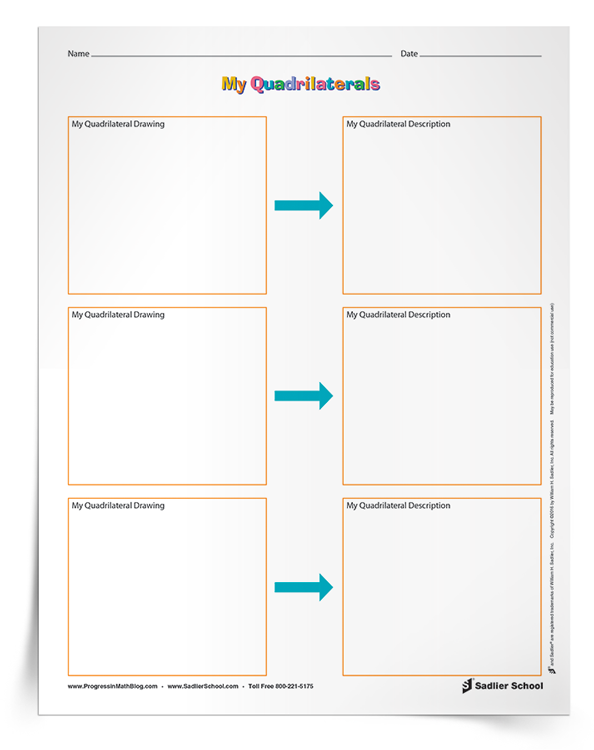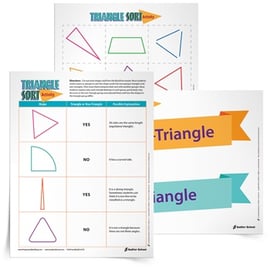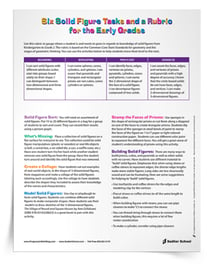September 26, 2016 k-2-geometry, 3-5-geometry
3 Quadrilateral Activities to Learn the Names of Quadrilaterals
By: Jeff Todd
Here are some quadrilateral activities that you can use in your first through third grade classes as well as some advice about how to use them. After a quick review of what students need to know about the names of quadrilaterals, I am sharing with you 1) a story book that you can use during your reading class, 2) a word list for quad- and quart- that you can use to design a vocabulary activity, and 3) a download for students using straws or other manipulatives.
 Here are the names of quadrilaterals that students need to know by grade level. In first grade students need to recognize squares, rectangles, rhombuses and isosceles trapezoids. In second grade they need to also know (non-isosceles) trapezoids and parallelograms as well as recognize right angles. By third grade students need to recognize the above shapes and know that there are quadrilaterals that are not squares, rectangles, rhombuses, trapezoids or parallelograms. A final note on vocabulary is that parallel sides is a fourth grade topic and shouldn’t be something that you dwell on though you might mention it.
Here are the names of quadrilaterals that students need to know by grade level. In first grade students need to recognize squares, rectangles, rhombuses and isosceles trapezoids. In second grade they need to also know (non-isosceles) trapezoids and parallelograms as well as recognize right angles. By third grade students need to recognize the above shapes and know that there are quadrilaterals that are not squares, rectangles, rhombuses, trapezoids or parallelograms. A final note on vocabulary is that parallel sides is a fourth grade topic and shouldn’t be something that you dwell on though you might mention it.
The reasoning students need to use in quadrilateral activities is closely tied to the figures they need to know in each grade. For first grade, students need simple reasoning such as recognizing, naming, sorting and building these quadrilaterals. In second grade they need to name the figures and describe their attributes. By third grade students should analyze, compare, classify and draw quadrilaterals with restraints.
The first of the quadrilateral activities is the reading of a book, If You Were a Quadrilateral, by Molly Blaisdell, available for purchase online from many sources and discusses the names of quadrilaterals. This would be an appropriate book for a read-aloud. You could use the book at a math center and include the activity at the end, making drawings or paintings of quadrilaterals.
The second of the quadrilateral activities is to conduct a brainstorm with your students about words that contain quart and quad. This will help them remember the word roots that have to do with four and fourths. I am providing you with the list below so that you can be ready with some words of your own:
-
Quad (a competitive skating jump with four spins)
-
Quad (a term from the video game Call of Duty when four men are killed)
-
Quad (an off-road vehicle with four wheels)
-
Quad Cities (Davenport, Iowa, Bettendorf, Rock Island and Moline [East Moline] in Illinois)
-
Quadrangle (a square yard surrounded by buildings as a college campus or a jail)
-
Quadrant (an area divide in fourths, particularly a circle or the Cartesian coordinate plane)
-
Quadraphonic (sound coming from four speakers)
-
Quadrennial (every four years)
-
Quadriceps (a muscle group in the legs of a human)
-
Quadrillion/th (parts of the decimal number system)
-
Quadriplegic (a person who has paralysis of both arms and legs)
-
Quadrivium (from classical Greek education: arithmetic, geometry, music, and astronomy)
-
Quadruped (an animal with four feet)
-
Quadruple (multiply by four)
-
Quadruplet (four children born at one birth)
-
Quads (muscle group in the legs)
-
Quarantine (setting apart due to disease originally for forty days)
-
Quarter ($)
-
Quarter (one period in a football or basketball game)
-
Quarterback (football, halfway between the line of scrimmage and the halfback)
-
Quarterdeck (place on a ship where the officer on duty runs the ship and traditionally where the flag is flown)
-
Quarterfinals (game before semifinals in a competition)
-
Quartermaster (a member of the navigation team in the US Navy)
-
Quarters (living space on a ship)
-
Quartet (four singers or instruments playing together)
-
Squad (originally a military term meaning a troops in the formation of a square)
-
The French Quarter (a section of New Orleans)
The final activity that will help students learn the names of quadrilaterals is a downloadable activity for students. You will need to provide either straws, coffee stirrers or pieces of spaghetti—something that students can cut or break into pieces to build four-sided shapes. Students build shapes using the manipulatives, then copy the shape on to the activity sheet. In the space next to the drawing, they describe the attributes of the shape they made.
So if you are looking for quadrilateral activities, then click on the button above. There are separate directions for how to use the worksheet at first, second, and third grade levels. Each grade level also has a word bank to assist students in their descriptions.
Remember there are some other names of quadrilaterals besides square, rectangle, rhombus, parallelogram and trapezoid. Kites have two pairs of congruent sides and no parallel sides. Concave quadrilaterals are known as chevrons, arrow heads or darts. Students might not be tested on the names of these shapes, but knowing about them is helpful to their development as mathematical thinkers and may be useful when they use the downloadable activity.
RELATED RESOURCES:
|
|
|








